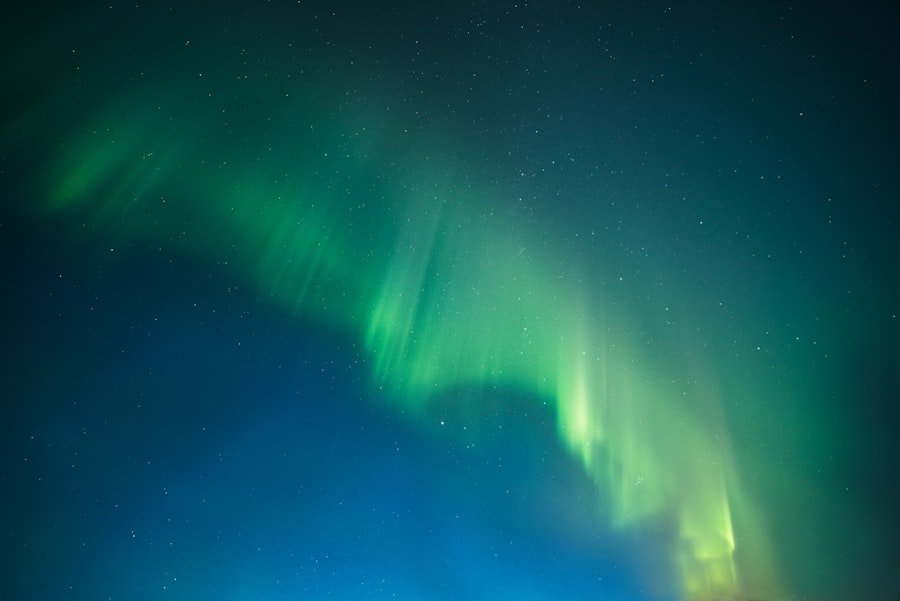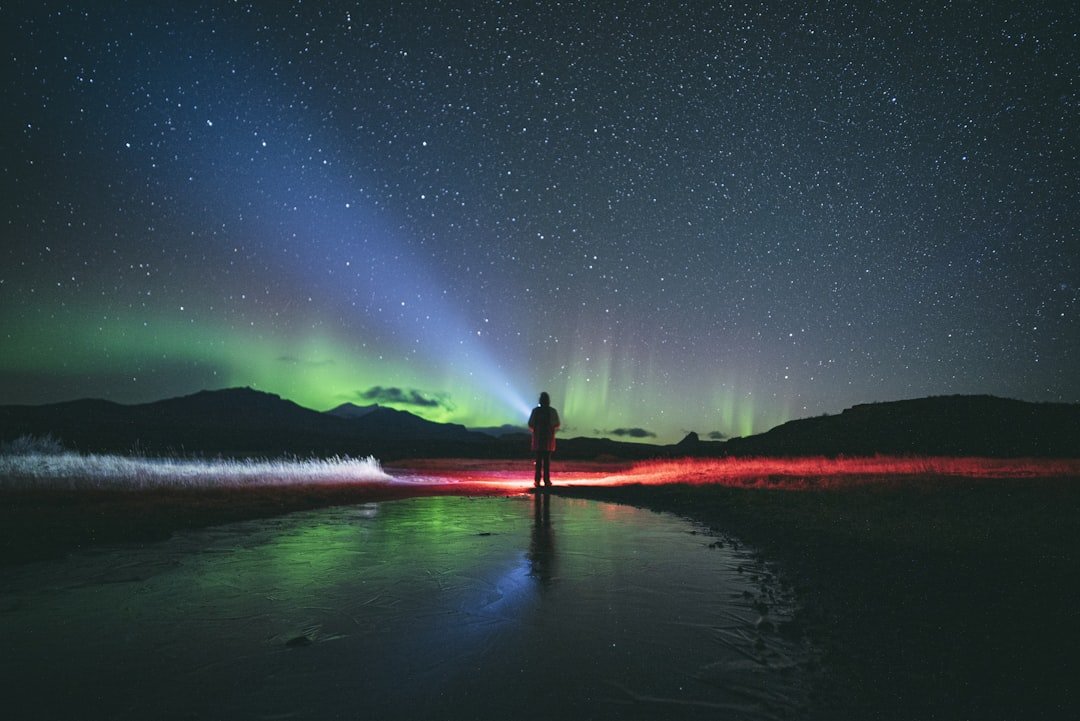The Northern Lights, also known as Aurora Borealis, are a natural phenomenon that occurs when charged particles from the sun collide with gases in the Earth’s atmosphere. These collisions produce beautiful and colorful light displays in the sky, typically in the polar regions. The colors of the Northern Lights are determined by the type of gas particles that are colliding. For example, oxygen produces green and red lights, while nitrogen produces blue and purple lights. The Northern Lights can appear in various forms, including arcs, curtains, and even coronas. This breathtaking display of lights has fascinated people for centuries and continues to be a popular natural wonder to witness.
The Northern Lights are best viewed in areas with minimal light pollution and clear, dark skies. This is why they are most commonly seen in northern regions such as Alaska, Canada, Iceland, and Scandinavia. However, under the right conditions, the Northern Lights can also be visible in more southern locations, including parts of the United States such as Nevada. While the chances of seeing the Northern Lights in Nevada are not as high as in the polar regions, it is still possible to catch a glimpse of this mesmerizing phenomenon under the right circumstances.
Key Takeaways
- The Northern Lights, also known as Aurora Borealis, are a natural light display in the Earth’s sky, predominantly seen in high-latitude regions.
- Factors affecting Northern Lights visibility include solar activity, weather conditions, and light pollution.
- Nevada’s geographic location makes it a potential spot for viewing the Northern Lights, especially in the northern parts of the state.
- The best times to see the Northern Lights in Nevada are during the winter months, particularly around the equinoxes.
- Tips for viewing the Northern Lights in Nevada include finding a dark, open area away from city lights and checking the aurora forecast before heading out.
Factors Affecting Northern Lights Visibility
Several factors can affect the visibility of the Northern Lights in any given location. One of the most important factors is solar activity. The Northern Lights are more likely to be visible during periods of high solar activity, such as during solar flares or coronal mass ejections. These events send a higher number of charged particles towards the Earth, increasing the likelihood of collisions with gases in the atmosphere and thus producing more intense and widespread displays of the Northern Lights.
Another important factor is the Earth’s magnetic field. The Northern Lights are typically seen closer to the Earth’s magnetic poles, which is why they are more commonly visible in northern regions. However, during periods of high solar activity, the auroral oval (the area where the Northern Lights are most likely to be seen) can expand further south, increasing the chances of seeing the lights in more southern locations such as Nevada.
Weather conditions also play a significant role in Northern Lights visibility. Clear, dark skies are essential for viewing the lights, so any cloud cover or light pollution can hinder visibility. Additionally, the time of year can affect the visibility of the Northern Lights, as longer nights during the fall and winter months provide more opportunities for viewing.
Geographic Location of Nevada
Nevada is a state located in the western United States, known for its diverse terrain including deserts, mountains, and valleys. While it is not typically associated with Northern Lights viewing, its geographic location does place it within the potential viewing range under certain conditions. Nevada’s latitude is relatively low compared to traditional Northern Lights viewing areas, but during periods of high solar activity, the lights can sometimes be seen further south than usual.
The state’s varied topography also offers different viewing opportunities. For example, areas with higher elevation and less light pollution, such as remote mountain ranges or desert regions, may provide better chances of seeing the Northern Lights. Additionally, Nevada’s clear desert skies can offer ideal conditions for stargazing and potentially catching a glimpse of the Northern Lights when they make a rare appearance in the state.
Best Times to See the Northern Lights in Nevada
| City | Best Time to See Northern Lights |
|---|---|
| Reno | September to March |
| Las Vegas | October to February |
| Elko | September to March |
While Nevada may not be a traditional Northern Lights viewing destination, there are still specific times when the lights may be more likely to be visible in the state. As mentioned earlier, periods of high solar activity increase the chances of seeing the Northern Lights further south than usual. Therefore, keeping an eye on solar activity forecasts and space weather reports can help determine when conditions might be favorable for viewing the lights in Nevada.
In general, fall and winter months tend to offer better opportunities for seeing the Northern Lights due to longer periods of darkness. During these seasons, nights are longer, providing more time for potential sightings. Additionally, clear and dark skies are essential for viewing the lights, so monitoring weather forecasts for clear nights can also increase the chances of witnessing this natural spectacle.
It’s important to note that while there may be specific times when conditions are more favorable for seeing the Northern Lights in Nevada, sightings are never guaranteed. The lights are a natural phenomenon that can be unpredictable, so patience and perseverance are key when attempting to view them.
Tips for Viewing the Northern Lights in Nevada
For those hoping to catch a glimpse of the Northern Lights in Nevada, there are several tips that can help maximize the chances of a successful sighting. Firstly, finding a location with minimal light pollution is crucial. This may involve traveling to remote areas away from city lights and urban development. Remote mountain ranges or desert regions with higher elevation can offer darker skies and better visibility for stargazing and potential Northern Lights sightings.
Monitoring solar activity and space weather reports is also important. Websites and apps dedicated to space weather provide real-time data on solar activity, including solar flares and coronal mass ejections that can increase the likelihood of seeing the Northern Lights further south than usual. Keeping an eye on these reports can help plan potential viewing opportunities.
Additionally, being prepared for long periods of waiting is essential when attempting to view the Northern Lights. Patience is key, as sightings are never guaranteed and may require spending extended periods outdoors during nighttime hours. Dressing warmly and bringing supplies such as blankets, hot drinks, and snacks can make the experience more comfortable and enjoyable.
Alternative Ways to Experience the Northern Lights in Nevada

While traditional viewing of the Northern Lights involves looking up at the night sky, there are alternative ways to experience this natural phenomenon in Nevada. For example, some tour companies and organizations offer Northern Lights-themed events and activities that provide educational opportunities to learn about the science behind the lights and their cultural significance.
Another alternative way to experience the Northern Lights is through photography. Capturing the beauty of the lights through photography allows for a different perspective and a lasting memory of the experience. Photography workshops or guided tours focused on capturing the Northern Lights can provide valuable skills and techniques for capturing stunning images of this natural wonder.
Additionally, some resorts or lodges in Nevada may offer special packages or amenities geared towards stargazing and potential Northern Lights sightings. These accommodations may provide optimal viewing locations away from light pollution and offer amenities such as outdoor observation decks or guided stargazing tours.
Other Places to See the Northern Lights in the United States
While Nevada offers a unique opportunity to potentially see the Northern Lights further south than usual, there are other locations within the United States that are more traditionally associated with Aurora Borealis sightings. For example, Alaska is one of the top destinations for viewing the lights due to its proximity to the Earth’s magnetic pole and minimal light pollution in many remote areas.
Other northern states such as Minnesota, Michigan, and Maine also offer opportunities for seeing the Northern Lights under certain conditions. These states have more northern latitudes and darker skies in rural areas that can provide ideal conditions for viewing this natural phenomenon.
In addition to mainland locations, certain regions such as parts of Hawaii and even occasionally as far south as Texas have reported rare sightings of the Southern Lights (Aurora Australis), which are similar to the Northern Lights but occur in the southern hemisphere.
Overall, while traditional viewing locations such as Alaska and Canada remain popular choices for witnessing the Northern Lights, unique opportunities exist for potential sightings in more southern locations such as Nevada under specific conditions. Whether through traditional stargazing or alternative experiences such as photography or educational events, experiencing this natural wonder is a memorable and awe-inspiring endeavor.
Discover the breathtaking natural wonders of Nevada with an unforgettable experience of witnessing the mesmerizing northern lights. While many may not associate Nevada with this celestial spectacle, the state’s unique geographical location offers a rare opportunity to witness this phenomenon. For more insights into the excitement and beauty of Nevada, check out the article “Unveiling the Excitement in Las Vegas” on Nevada Today.
FAQs
What are the Northern Lights?
The Northern Lights, also known as Aurora Borealis, are a natural light display in the Earth’s sky, predominantly seen in high-latitude regions around the Arctic and Antarctic.
Can you see the Northern Lights in Nevada?
It is extremely rare to see the Northern Lights in Nevada. The state’s location at a lower latitude and its light pollution make it unlikely to witness the Aurora Borealis in Nevada.
Where is the best place to see the Northern Lights?
The best places to see the Northern Lights are in high-latitude regions such as Alaska, Canada, Iceland, Norway, Sweden, and Finland.
What causes the Northern Lights?
The Northern Lights are caused by the collision of charged particles from the sun with atoms in the Earth’s atmosphere. This collision releases energy in the form of light, creating the beautiful auroras.
When is the best time to see the Northern Lights?
The best time to see the Northern Lights is during the winter months when the nights are longer and darker. The peak season for viewing the Aurora Borealis is typically from September to March.


